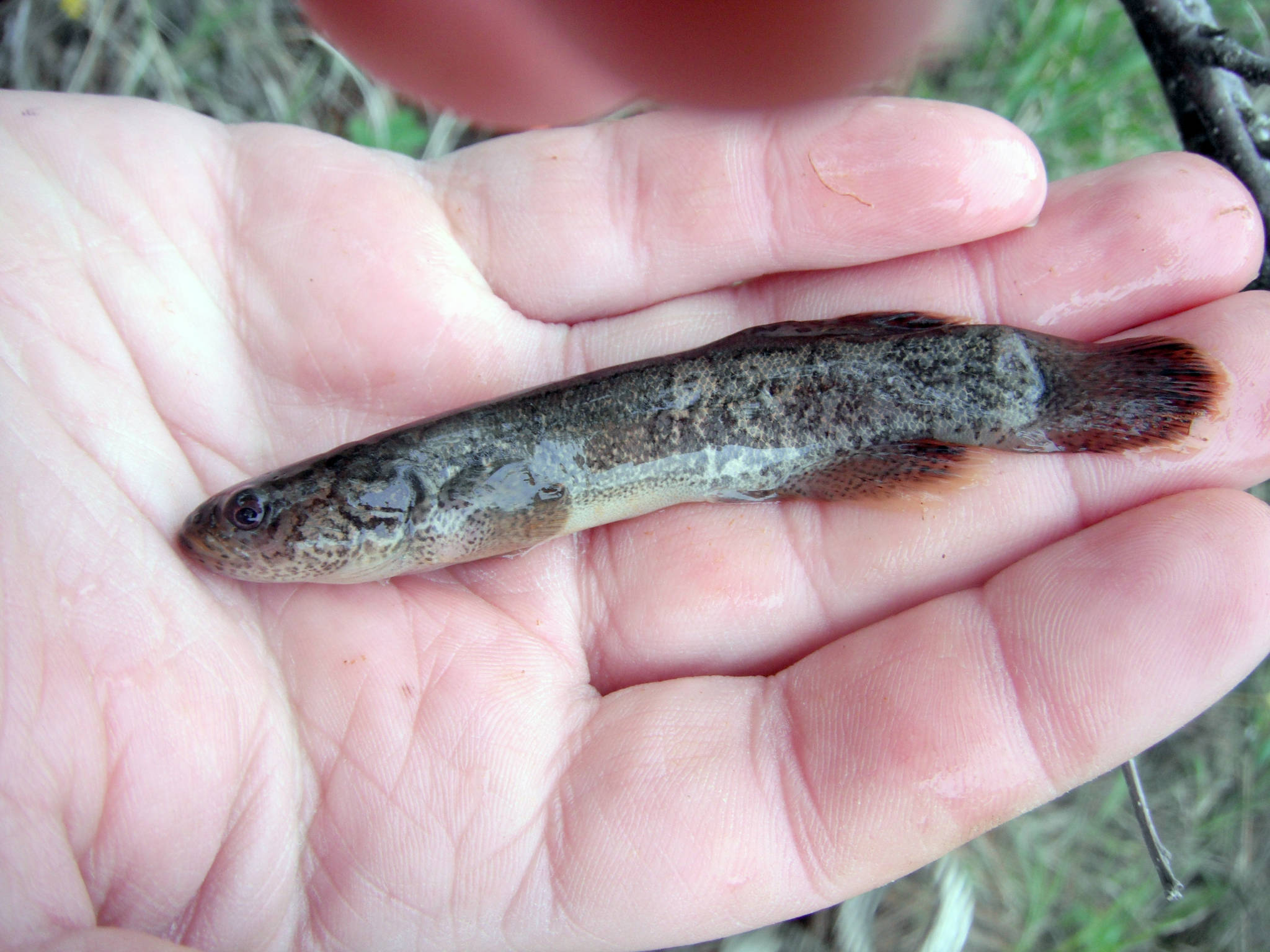By MATT BOWSER
Recently, I stopped by a shallow, scuzzy pond by Candlelight Drive in Kenai to look for Alaska blackfish. I had heard that they had been found in the stream that runs through the Kenai Golf Course downstream of this little this pond.
The fish were not hard to find. As I walked along the squishy shore, a few 6-inch long blackfish darted from the shoreline. One dove into the mud by the shore, a typical behavior for this remarkable species.
The Alaska blackfish is the only air-breathing fish in the arctic and one of only three fish species in the world that obtain atmospheric oxygen through a modified esophagus.
This ability to breathe air allows them to thrive in shallow, weedy, mucky wetlands where other fish would die due to lack of oxygen. Blackfish reportedly can burrow into wetland moss when water levels drop temporarily, surviving as long as they remain moist. In winter, blackfish sometimes breathe air through holes in the ice made by muskrats.
The cold-hardiness of Alaska blackfish is legendary, with multiple reports of these fish apparently coming back to life after having been frozen. Subsequent studies demonstrated that blackfish cannot survive being completely frozen. Nonetheless, they are extremely hardy and can remain active under the ice in oxygen-poor lakes and ponds where other fish may not survive.
Known in the Iñupiaq language as iłuuqiñiq, which describes it as a dark-skinned bottom dweller, and in the Koyukon language as oonyeeyh, which means “the one you survive on,” the blackfish has long been harvested by Alaska’s indigenous peoples as food for themselves and their dogs.
In late winter when other fresh food sources were scarce, these fish were caught in specially designed traps where they gathered under openings in the ice to gulp air. Though blackfish are only 7 to 8 inches in length, they can be taken in large quantities and are considered to be extremely nutritious.
In the geologic past, Alaska blackfish ranged over a broad area from eastern Russia to Southcentral Alaska. A fossil specimen found in the Homer area shows that blackfish were once present on the Kenai Peninsula. In recent times this species occurs naturally in eastern Russia and western, northern and Interior Alaska.
Until lately, blackfish had long been absent from Southcentral Alaska. Bob Chlupach, a retired Alaska Department of Fish & Game biologist who studied blackfish in the 1970s, told me that blackfish were accidentally transported to Anchorage in the 1950s.
The story was that a U.S. Fish & Wildlife Service Grumman Goose seaplane had flown into Lake Hood from Bethel. As the plane was brought out of the water onto a concrete ramp and drained, live blackfish were discharged from the plane into the lake.
There is also a 1959 article in the Fairbanks Daily News-Miner detailing how 300 Alaska blackfish were temporarily kept in bins in Lake Hood on their way to the National Aquarium in Washington, D.C.
From Lake Hood, blackfish made their way through connected wetlands to other Anchorage water bodies. Later, blackfish were transported intentionally or unintentionally to waters in the Palmer and Wasilla area, where they flourished.
By the 1970s, Alaska blackfish were suspected of causing declines of sportfish in Anchorage lakes. In 1972, an attempt was made to eradicate blackfish in Anchorage’s Jewel Lake using rotenone, a poison that interferes with respiration, but the air-breathing blackfish persisted.
In the 1990s, ADF&G biologists Terry Bendock and Jeff Breakfield found Alaska blackfish in the city of Kenai. The fish now occupy two streams: the unnamed creek that flows through the Kenai Golf Course and the unnamed stream that runs under the Spur Highway between Walmart and the Kenai New Life Assembly of God.
Both streams drain into the brackish waters of the lower Kenai River, which are not good habitat for blackfish. This barrier has apparently kept them from spreading to other streams in the Kenai River drainage, but blackfish have reportedly showed up farther north in the string bog off of Marathon Road.
Local biologists do not know how Alaska blackfish were brought to the city of Kenai. We also cannot say how long the Kenai blackfish population will remain contained within the two aforementioned streams and surrounding wetlands. We do know that blackfish are hard to get rid of and that their presence will change things.
How introduced blackfish will fit in to the Kenai River system is difficult to forecast, but we can make a few predictions. This exceptionally tough air breather will be able to colonize currently fishless swamps and small ponds. Larger fish, river otters, mink, loons, grebes, terns and people eat blackfish, so these predators may benefit.
As they do in other places, blackfish will voraciously consume aquatic insects and tiny crustaceans, perhaps eating so much that they leave less food for other fish species. There is some anecdotal evidence from the Wasilla and Anchorage areas that introduced blackfish have led to diminished populations of sticklebacks and rainbow trout, both native species, through competition for the same invertebrates for food.
While I thoroughly enjoyed seeing these hardy, unfamiliar blackfish at that little pond in Kenai, I am concerned about how they might affect other species — especially other fish — in the Kenai River system.
Matt Bowser serves as Entomologist at Kenai National Wildlife Refuge. He thanks Bob Chlupach, Lucas Byker, Dr. Michael A. Bell and Jeff Breakfield for sharing information on blackfish in Southcentral Alaska; Celia Rozen and Sharon Prien for library sleuthing; and Ronald H. Brower for providing the meaning of the Iñupiaq name for blackfish. Find more Refuge Notebook articles (1999–present) at https://www.fws.gov/refuge/Kenai/community/refuge_notebook.html.

